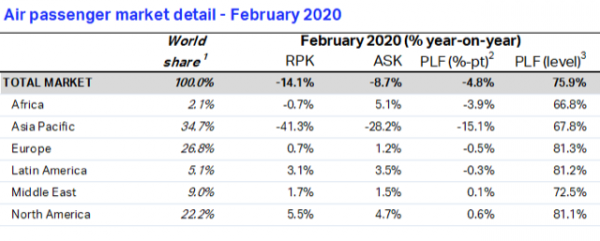SINGAPORE, 6 April 2020: Global passenger traffic data for February 2020 (measured in total revenue passenger-km or RPKs) fell 14.1% compared to February 2019, the International Air Transport Association (IATA) reported at the weekend.
This was the steepest decline in traffic since 9.11 and reflected collapsing domestic travel in China and sharply falling international demand to/from and within the Asia-Pacific region, owing to the spreading Covid-19 virus and government-imposed travel restrictions.
February capacity (available seat km or ASKs) fell 8.7% as airlines scrambled to trim capacity in line with plunging traffic, and load factor fell 4.8 percentage points to 75.9%.

“Airlines were hit by a sledgehammer called COVID-19 in February. Borders were closed in an effort to stop the spread of the virus. And the impact on aviation has left airlines with little to do except cut costs and take emergency measures in an attempt to survive in these extraordinary circumstances. The 14.1% global fall in demand is severe, but for carriers in the Asia-Pacific, the drop was 41%. And it has only grown worse. Without a doubt this is the biggest crisis that the industry has ever faced,” said IATA’s director general and CEO, Alexandre de Juniac.
International Passenger Markets
February international passenger demand fell 10.1% compared to February 2019, the worst outcome since the 2003 SARS outbreak and a reversal from the 2.6% traffic increase recorded in January. Europe and the Middle East were the only regions to see a year-over-year traffic rise. Capacity fell 5.0%, and load factor plunged 4.2 percentage points to 75.3%.

Asia-Pacific airlines’ February traffic plummeted 30.4% compared to the year-ago period, steeply reversing a 3.0% gain recorded in January. Capacity fell 16.9%, and load factor collapsed to 67.9%, a 13.2-percentage point drop compared to February 2019.
European carriers’ February demand was virtually flat compared to a year ago (+0.2%), the region’s weakest performance in a decade. The slowdown was driven by routes to/from Asia, where the growth rate slowed by 25 percentage points in February, versus January. Demand in markets within Europe performed solidly despite some initial flight suspensions on the routes to/from Italy. However, March data will reflect the impact of the spread of the virus across Europe and the related disruptions to travel. February capacity rose 0.7%, and load factor slipped 0.4 percentage point to 82.0%, which was the highest among regions.
Middle Eastern airlines posted a 1.6% traffic increase in February, a slowdown from the 5.3% year-over-year growth reported in January largely owing to a slowdown on Middle East-Asia-Pacific routes. Capacity increased by 1.3%, and load factor edged up 0.2 percentage point to 72.6%.
North American carriers had a 2.8% traffic decline in February, reversing a 2.9% gain in January, as international entry restrictions hit home and volumes on Asia-North America routes plunged 30%. Capacity fell 1.5%, and load factor dropped 1.0 percentage point to 77.7%.
Latin American airlines experienced a 0.4% demand drop in February compared to the same month last year. This actually was an improvement over the 3.5% decline recorded in January. However, the spread of the virus and resulting travel restrictions will be reflected in March results. Capacity also fell 0.4%, and load factor was flat compared to February 2019 at 81.3%.
African airlines’ traffic slipped 1.1% in February, versus a 5.6% traffic increase recorded in January and the weakest outcome since 2015. The decline was driven by around a 35% year-on-year traffic fall in the Africa-Asia market. Capacity rose 4.8%, however, and load factor sagged 3.9 percentage points to 65.7%, lowest among regions.







